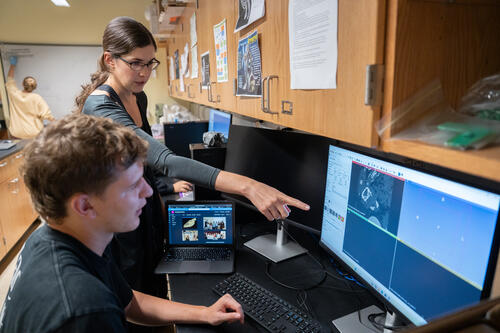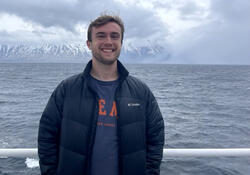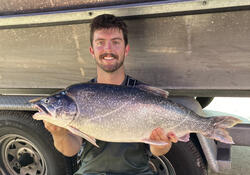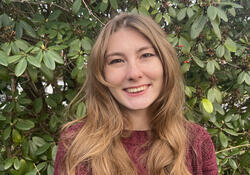
Mackenzie Gerringer, associate professor of biology, works with Zebulun Soper ’26 during a deep-sea physiology and ecology lab. (SUNY Geneseo/Matt Burkhartt)
Discovery of three new species of fishes found in the deep sea recently made national news, and SUNY Geneseo students assisted in their official naming.
Six biology majors co-authored associate professor Mackenzie Gerringer’s research, which was featured in the New York Times and other media.
Gerringer and her student researchers are leaders in deep-sea fish ecology and physiology, analyzing data collected worldwide in their campus lab. The discovery of the new snailfishes is shared with deep-sea biologists Jeffrey Drazen at the University of Hawai’i at Mānoa and Logan Peoples at the University of Montana.
“Students are full collaborators on our projects, and they bring a lot to the research. People of different backgrounds will see different things, so it’s very helpful to have a diverse team that can ask different questions and approach these problems in new ways,” says Gerringer. “Together we are answering questions that no one knows the answer to, and the students are coming up with hypotheses, collecting data, writing up results, and then sharing them with the scientific community.”
Since joining the biology department at Geneseo in 2019, Gerringer has mentored 39 students in the research lab and 10 in science communication projects and published research with 32 Geneseo undergraduate co-authors. She also brings research into classes at Geneseo and has published a pedagogy manuscript on engaging students in deep-sea research, funded by a National Oceanic and Atmospheric Administration (NOAA) and National Marine Sanctuary Foundation grant.
Gerringer’s current team is examining how species have adapted to the extreme pressures of the deep ocean, supported by an $892,000 National Science Foundation grant. In Summer 2026, Gerringer and a number of students will embark on a deep-sea exploration in the Mediterranean Sea.
Gerringer says her commitment to providing undergraduate research opportunities is inspired in part by her own research at Whitman College, where she earned her bachelor’s degree in biology and German studies. “It really changed my life,” she says. “I know first-hand how impactful these learning experiences can be. Many students find their identities as scientists. They grow in feelings of belonging, their computer and presentation skills, and often support and teach each other in the lab.”
Several of Gerringer’s Geneseo research students, all biology majors, are now pursuing marine-related advanced degrees or careers.

Brett Woodworth ’22
Woodworth is earning a master’s degree in oceanography from the University of New Hampshire and specializes in using soundwave data captured by sonar to map coral reefs. He is also earning a Category A Certificate in hydrography for ocean mapping.
At Geneseo, he worked on multiple deep-sea projects and is one of the six students who co-authored the recent snailfish research. His research experience at Geneseo helped him earn two internships. After his junior year, he spent a summer comparing swimming speeds of shallow and deep-sea fish through an REU internship with the University of Washington. After graduation, he was part of the team aboard the NOAA Ship Okeanos Explorer that mapped parts of the 5,000-meter-deep Aleutian Trench in Alaska.
“The first thing that grabbed me working with Professor Gerringer was the mystery of it,” says Woodworth. “You get to explore a world we don’t really know about. I’d like to combine both the mapping world and the biological world in very deep ocean areas.”

Ryan Bohen ’22
As a fisheries biologist for the Pennsylvania Fish and Boat Commission, Bohen samples and analyzes fish populations in Lake Erie as part of its management for recreational and commercial fishing.
“I had no prior research experience, and Professor Gerringer made it super accessible,” says Bohen, who earned a master’s degree in natural resources from the University of Wisconsin–Stevens Point. “I was involved in every point of the research process. She encouraged and challenged me. I didn’t even know a career in fisheries was possible. I went from liking to fish in Lake Erie as a kid to fisheries being my full-time job.”
As a student, Bohen also started an ongoing working relationship between Geneseo and the New York State Department of Environmental Conservation (DEC) to study local lake ecosystems.

Emily Wynne ’25
In addition to a science communication class and research with Gerringer, Wynne completed an internship through Mote Marine Laboratory and Aquarium (FL) studying harmful algal blooms. She’s now earning her master’s degree in environmental science at Florida Gulf Coast University and continuing her study of harmful algal blooms in marine environments. Blooms can produce toxins, which contaminate seagrass or scallops and other shellfish, ultimately harming organisms that eat them. Blooms can also reduce oxygen in the water system when they die and decompose.
“I’m studying how salinity, temperature, and turbulence of the water influence the amount of phytoplankton and toxin production,” says Wynne. “I enjoy the exploration and public health aspect of my work.”